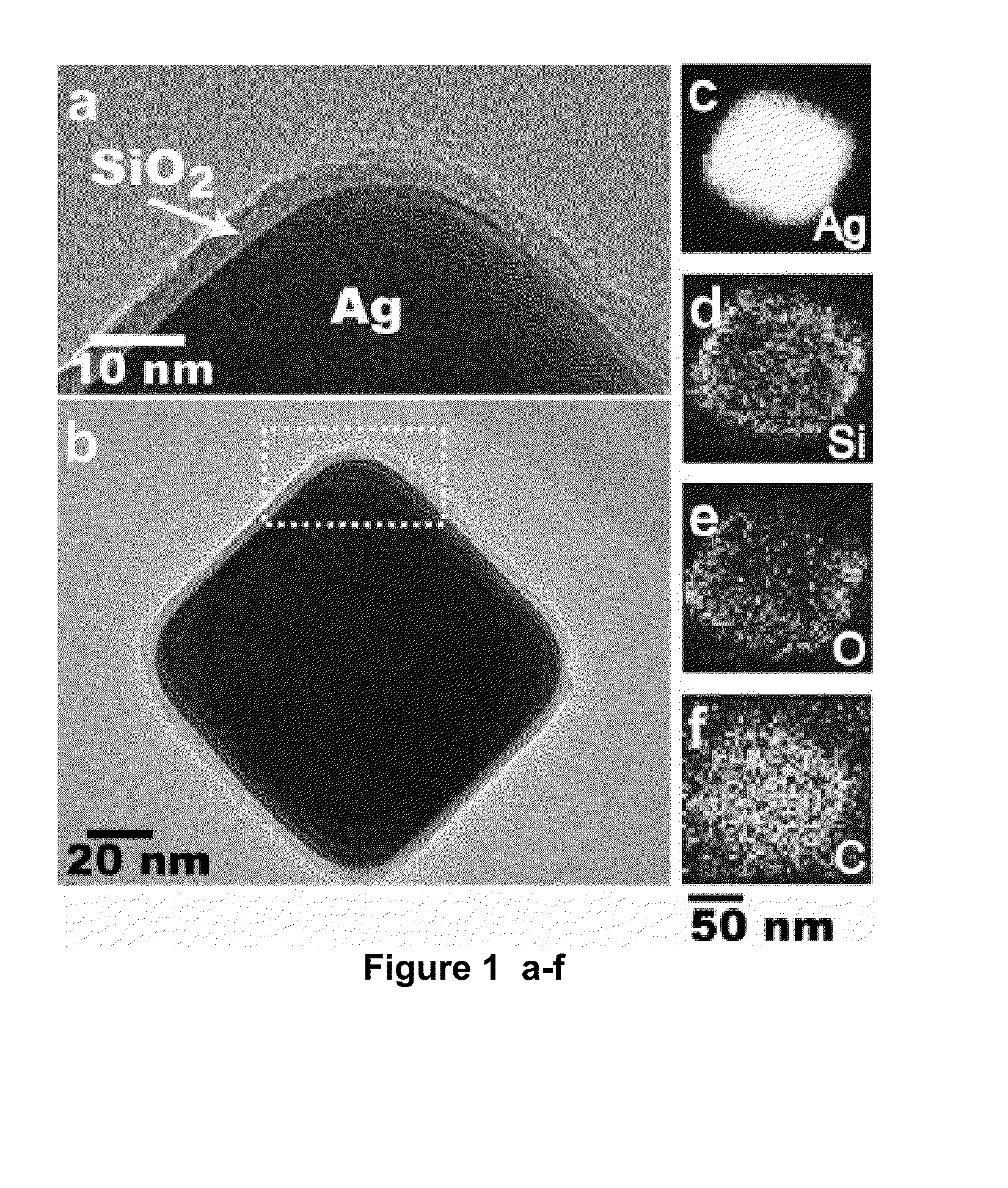Nanoparticle Plasmonic Sensor for Localized Surface Plasmon Resonance
a plasmonic sensor and nanoparticle technology, applied in the field of nanoparticle plasmonic sensor, can solve the problems of impracticality for widespread adoption in biological laboratories, and achieve the effect of affecting the thickness and quality of the silica layer and high molecular weigh
- Summary
- Abstract
- Description
- Claims
- Application Information
AI Technical Summary
Benefits of technology
Problems solved by technology
Method used
Image
Examples
example 1
Membrane-Protein Binding Measured with Solution-Phase Plasmonic Nanocube Sensors
[0100]We describe a solution-phase sensor of lipid-protein binding based on localized surface plasmon resonance (LSPR) of silver nanocubes. When silica-coated nanocubes are mixed into a suspension of lipid vesicles, supported membranes spontaneously assemble on their surfaces. Using a standard laboratory spectrophotometer, we calibrate the LSPR peak shift due to protein binding to the membrane surface and then characterize the lipid-binding specificity of a pleckstrin-homology domain protein.
[0101]Here, we report a platform that enables label-free measurements of protein binding to membrane surfaces on a standard laboratory spectrophotometer. We have previously described label-free detection using the LSPR of thiolated silver nanocubes immobilization on flat substrates.9 This configuration required multiple reactions, a customized detection system, and ultimately proved similarly impractical as the other...
example 2
Detection with Antibody Conjugation to Solution-Phase Plasmonic Nanocube Sensors
[0132]Immobilized GLYMO on Oxidized Silicon Particle.
[0133]Take Ag@SiO2 particle and coat it with epoxy group for antibody linkage. Follow the aqueous protocol published in Chem. Mater. 1997, 9, 2577-2582, hereby incorporated by reference, or as described in Example 1. GLYMO: 3-glycidoxypropyltrimethoxysilane[0134]1. Take 500 ul of Ag@SiO2 particle. Use centrifuge to spin down the particles and remove most of ethanol.[0135]2. Prepare coating solution. Prepare 50% of ethanol-water as solvent. Add GLYMO in the solvent to reach 30% wt.[0136]3. Use 6M HCl to adjust the pH below 4.[0137]4. Mix with particle overnight.[0138]5. Wash particle with ethanol and follow with acetone. If the particles are not used right away, store in acetone
[0139]Coating Antibody (Example: Hepcidin Antibody) on Epoxy Group Coated Ag@SiO2.
[0140]Coupling buffer: 1×PBS, pH=8.5; Washing buffer. 1×PBS, pH=7.4[0141]1. Remove the acetone a...
example 3
Silver Nanocube Functionalization with Antibody
[0153]Modification of silica coated silver nanocubes with aldehyde functional groups and capture antibodies can be carried out by the following:
[0154]Take LSPR Spectrum of untreated silica coated cubes to determine maximum wavelength of absorbance:[0155](a) Prepare 11-(triethoxy silyl) undecanal solution which is 1% (v / v) in a 95% Ethanol: 5% H2O solution.[0156](b) Add 50 uL silica coated silver nanocubes to 950 uL of 11-(triethoxy silyl) undecanal solution.[0157](c) Incubate at room temperature for 40 minutes with constant mixing. The timing of this reaction can be adjusted to either increase or decrease the amount of 11-(triethoxy silyl) undecanal bound to the surface of the nanocubes.[0158](d) Using the initial maximum LSPR absorbance before treatment with 11-(triethoxy silyl) undecanal, the LSPR shift can be monitored after reaction to determine the mass of 11-(triethoxy silyl) undecanal coupled to the silica coated silver nanocubes...
PUM
 Login to View More
Login to View More Abstract
Description
Claims
Application Information
 Login to View More
Login to View More - R&D
- Intellectual Property
- Life Sciences
- Materials
- Tech Scout
- Unparalleled Data Quality
- Higher Quality Content
- 60% Fewer Hallucinations
Browse by: Latest US Patents, China's latest patents, Technical Efficacy Thesaurus, Application Domain, Technology Topic, Popular Technical Reports.
© 2025 PatSnap. All rights reserved.Legal|Privacy policy|Modern Slavery Act Transparency Statement|Sitemap|About US| Contact US: help@patsnap.com



